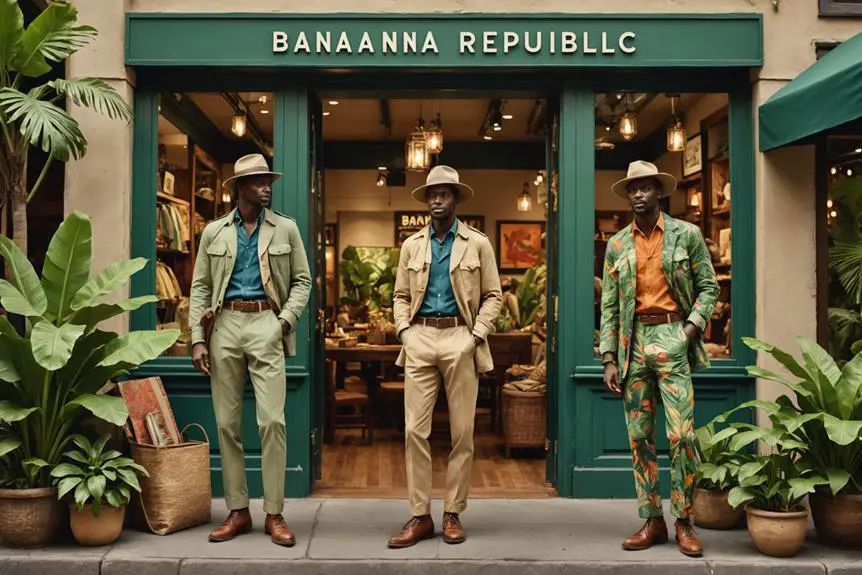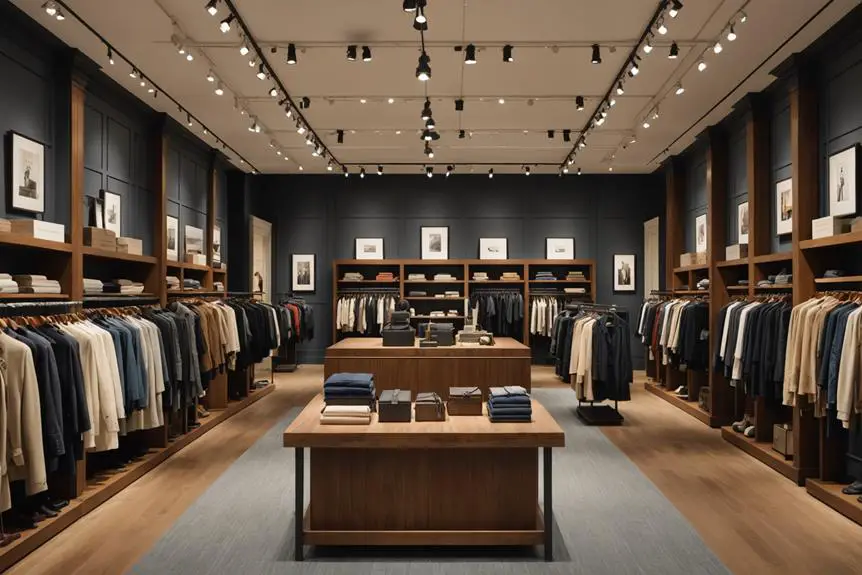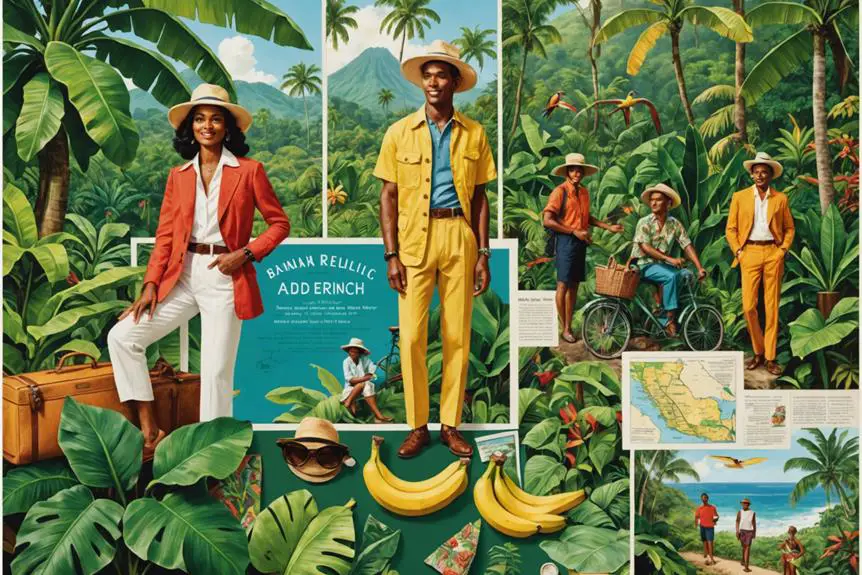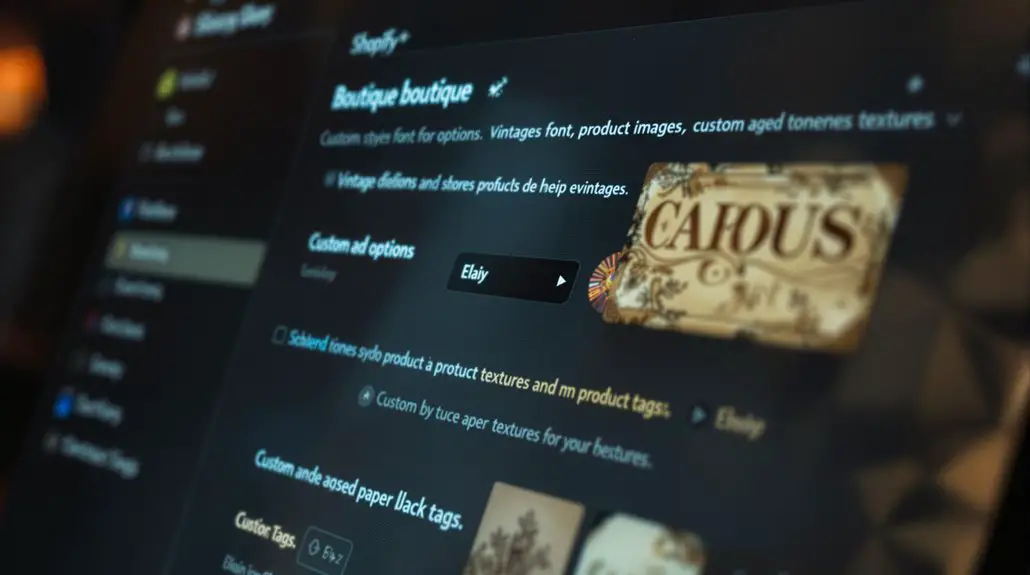You might find Banana Republic's evolution fascinating, as it started in 1978 when Mel and Patricia Ziegler co-founded the brand in California, focusing on vintage military surplus and travel-inspired clothing. After Gap Inc. acquired it in 1983, the company shifted toward a more upscale image, distancing itself from its adventurous roots. By the 2020s, under Nicole Wiesmann's leadership, the brand embraced modern consumer preferences with innovative collaborations, such as the one with designer Peter Do. Despite facing challenges from fast fashion and the impacts of the pandemic, Banana Republic's commitment to immersive retail experiences continues to shape its identity. There's much more to uncover about this iconic brand's journey in the world of fashion.
Founding of Banana Republic

In the late 1970s, Mel and Patricia Ziegler often found inspiration in their travels, which ultimately led them to co-found Banana Republic in 1978 in Mill Valley, California. Their vision centered on creating a unique retail experience that catered to adventurous consumers. Initially, the store specialized in vintage military surplus clothing, reflecting the Zieglers' passion for exploration and adventure. They designed their products around the concept of travel-themed clothing, appealing to those with a wanderlust spirit.
The Ziegler's innovative approach didn't just stop at the clothing; they crafted an immersive shopping environment that transported customers to far-off places. This focus on travel resonated deeply with their audience, establishing Banana Republic as a go-to destination for those seeking both style and adventure. However, their journey took a significant turn in 1983 when Gap Inc. acquired the brand.
This acquisition shifted Banana Republic's direction, steering it toward a more upscale image, which, over time, led to the phasing out of the unique travel-oriented items that defined its early days. The evolution of Banana Republic from its beginnings highlights the delicate balance between creative vision and commercial pressures.
Evolution of Brand Identity
Often seen as a case study in brand evolution, Banana Republic's identity has shifted dramatically since its founding. Initially, it focused on travel-themed clothing, creating an adventurous shopping atmosphere. After Gap Inc. acquired the brand in 1983, rebranding efforts distanced Banana Republic from its original concept, steering it toward upscale retail and conventional luxury products. This shift marked a turning point, as the unique travel-oriented items began to dwindle.
By the 2020s, under Nicole Wiesmann's leadership, Banana Republic sought to redefine its identity once more. The brand aimed to position itself alongside luxury competitors through higher-end garments and strategic partnerships. A notable collaboration in 2023 with designer Peter Do showcased this renewed focus, aiming to attract a modern customer base.
Here's a concise overview of Banana Republic's evolution:
| Year | Key Changes | Focus Shift |
|---|---|---|
| 1978 | Founding with travel themes | Adventure and exploration |
| 1983 | Acquisition by Gap Inc. | Rebranding to upscale |
| 1988 | Loss of creative control | Conventional luxury |
| 2020s | Leadership of Nicole Wiesmann | Higher-end garments |
| 2023 | Collaboration with Peter Do | Modern appeal |
Retail Expansion and Challenges

Throughout its history, Banana Republic has frequently navigated the complexities of retail expansion and the challenges that accompany it. Since its founding in 1978, the brand has grown notably, operating over 700 locations worldwide by 2017. Your journey through Banana Republic's expansion highlights milestones like the opening of its first international store in Tokyo's Ginza district in 2005, and subsequent entries into South Korea and Kuwait by 2008.
However, the retail landscape changed dramatically, leading to substantial challenges. By late 2022, the U.S. store count dwindled to 379, a stark contrast to its previous growth due to the COVID-19 pandemic's impact, which resulted in the closure of over 225 store locations in August 2020. Additionally, the so-called "retail apocalypse" strained brick-and-mortar retailers, with Banana Republic facing stiff competition from fast fashion brands and a shift toward online shopping.
The brand's struggle to maintain market presence was evident when it closed all its UK stores in 2016 due to declining sales. These factors illustrate the intricate balance Banana Republic must strike between ambitious retail expansion and the challenges it encounters along the way.
Recent Developments and Strategies
Banana Republic is actively redefining its approach to stay relevant in a rapidly evolving retail landscape. In 2023, the brand made a significant move by collaborating with designer Peter Do for a fall/winter capsule collection. This partnership signals a commitment to higher-end garments, positioning Banana Republic to compete effectively with luxury brands.
To adapt to the increasing demand for e-commerce, the company has ramped up its online presence, now shipping to over 50 countries through third-party services. This shift reflects a broader strategy to connect with global consumers. Additionally, Banana Republic has implemented new marketing strategies that emphasize sustainability and ethical sourcing, aligning its brand with the values of today's conscientious shoppers.
In response to the ongoing retail apocalypse, the brand's store count was reduced to 379 by late 2022, showcasing a strategic consolidation. Under the leadership of VP of design Nicole Wiesmann, Banana Republic is repositioning itself for the 2020s, ensuring its offerings resonate with changing consumer preferences and market dynamics. These recent developments illustrate a proactive approach to secure a sustainable future in the competitive retail landscape.
Cultural Impact and Legacy

As Banana Republic adapts to modern retail challenges, its rich cultural impact and enduring legacy remain significant. You can see how the brand became synonymous with casual luxury, pioneering lifestyle branding in retail. Its unique store designs and immersive customer experiences set new benchmarks in the industry. These theatrical elements not only elevated customer service but also inspired many retailers to rethink their approaches.
In the 1980s and 1990s, Banana Republic's growth fueled the rise of upscale casual wear as a fashion category. This shift mirrored consumers' desire for authenticity in their clothing choices, positioning the brand as a cultural touchstone for travel and adventure. Its emphasis on quality and distinctive marketing strategies resonated deeply, creating a strong emotional connection with shoppers.
The legacy of Banana Republic continues to influence modern retail by showcasing the importance of crafting immersive experiences and weaving compelling brand narratives. As you navigate today's shopping landscape, you can appreciate how this brand laid the groundwork for lifestyle-focused retail, shaping not just consumer expectations but also the broader fashion industry.
Connection to Other Ventures
Three distinct ventures illustrate how Mel and Patricia Ziegler's entrepreneurial vision extends beyond Banana Republic. After establishing the brand, they launched The Republic of Tea, which emphasizes premium quality and unique offerings, much like their original ethos at Banana Republic. This venture reflects their commitment to delivering an exceptional customer experience, pairing well with the brand narratives they cultivated in their clothing line.
Moreover, their entrepreneurial spirit led to the creation of ZoZa.com, an innovative online platform that transcended traditional retail boundaries. Here, the Zieglers championed a new approach to lifestyle branding, continuing the storytelling tradition that first defined Banana Republic.
Both The Republic of Tea and ZoZa.com showcase how the Zieglers prioritized cultural engagement and originality in their marketing strategies. This broader entrepreneurial legacy not only keeps their original vision alive but also illustrates their adaptability in a changing marketplace. By intertwining quality with creativity, the Zieglers have successfully connected their various ventures, reinforcing the unique experiences that resonate with consumers across different industries.
Frequently Asked Questions
What Is the Backstory of Banana Republic?
To understand the backstory, you'll see how a unique vision transformed from vintage military surplus to an upscale retailer. As the brand evolved, it navigated corporate acquisition and a shift in creative direction.
What Does Banana Republic Mean in History?
When you explore the term "banana republic," you uncover its roots in politically unstable countries reliant on single cash crops. This dependency often led to corruption, inequality, and exploitation by foreign corporations throughout history.
Why Did They Name Themselves Banana Republic?
You'll find they named themselves Banana Republic to evoke a sense of adventure and exploration. This whimsical title reflects their passion for travel, enticing customers with a unique retail experience centered around safari-inspired clothing.
What Happened to Banana Republics?
You'll find that banana republics faced political upheaval, economic dependency, and exploitation. Foreign interests often manipulated local governance, leading to instability and socio-economic challenges that persist today, affecting the lives of countless individuals in these nations.



